Planning on going to Iguazú Falls but not sure exactly what to do or how much time you’ll need? I recommend spending three days in Puerto Iguazú. This gives you a day to visit the Parque Nacional do Iguaçu (National Park) and Parque das Aves (Aviary) in Brazil, a day to visit the Parque Nacional Iguazú (National Park) in Argentina, and a third day to spend extra time at Parque Nacional Iguazú or to do some fun activities around Puerto Iguazú.
While you could see both parks in two or two and a half days, I recommend staying a third day in case of rain or bad weather. It rains about 8-12 days per month year round in Puerto Iguazú, so giving yourself an extra day can really pay off.
For more information about going to Iguazú Falls, including when to go, where to stay, what to wear, and what to bring, check out my article Tips for Making the Most of Your Time at Iguazú Falls.
Day 1: Parque Nacional do Iguaçu (Iguaçu National Park – Brazil) and Parque das Aves
How to Get There
Buses: The least expensive way to get to Parque Nacional do Iguaçu from Puerto Iguazú is to take the Crucero del Norte bus. You can catch these buses from the main bus station in Puerto Iguazú. They leave every 2 hours and take about 30 minutes to arrive at the park entrance. Be sure to check the schedule ahead of time, and try to leave early in the morning to get in a full day in Brazil. The last bus leaves Parque Nacional do Iguaçu for Puerto Iguazú at 5:00 p.m. As of September 2014, round-trip tickets cost AR$80.
Taxis: Taxis in this area do not usually have meters, so you will need to agree on a price before getting in the cab. Due to having to go through customs, most taxi drivers will want to take you to the park, wait for you as long as you need, and then take you back to your hotel. Ask your hotel what you should expect to pay (around AR$400-450 for a round-trip to Parque Nacional do Iguaçu).
Be sure to take your passport and necessary documents in a ziplock bag. U.S., Canadian, and Australian citizens (and more) need a visa to enter Brazil, which must be done well ahead of time. U.S., Canadian, and Australian citizens also need to have paid Argentina’s reciprocity fee and printed the proof to return to Argentina.
Parque Nacional do Iguaçu (Iguaçu National Park – Brazil)
Hop on the park’s open air bus for a 20 minute ride from the Visitor Center Station to the Path of the Falls Stop. From there, walk along the 1200 meters (.75 miles) trail where you get to see amazing panoramic views of the waterfalls. Since most of the waterfalls are on the Argentinian side, visiting Parque Nacional do Iguaçu allows you to see them from across the river.

While most of the views of the waterfalls are from a distance, Parque Nacional do Iguaçu also gives you the opportunity to get a close up look at the largest, most incredible waterfall: Garganta del Diablo (Devil’s Throat). The Devil’s Throat is where the Path of the Falls trail ends. Here, you can walk out onto a bridge that curves around the Devil’s Throat, allowing you to feel the water coming off the falls.
Once you’ve taken in this spectacular view, you can ride an elevator up to the observatory deck for a view of the Devil’s Throat from above. From the top of the observatory deck, it’s just a short walk to Porto Canoas Square, where there is a restaurant (open from noon to 4:00 p.m.), a food court, and a gift shop. This is also where the bus station is; hop on the open-air bus back to go back to the Visitor Center Station.
I am a slow walker, I take tons of pictures, and I’m constantly on the lookout for animals near the trail. That being said, I was able to see everything in Parque Nacional do Iguaçu in about 3 hours. Faster walkers who take normal amounts of pictures could probably see everything in an hour or two.
Parque Nacional do Iguaçu (Brazil)
www.icmbio.gov.br/parnaiguacu/
Tel: 55 (45) 3521 8383
Email: parnaiguacu@icmbio.gov.br
Admission: R$49.20 (discounts for Brazilian, Argentinian, Paraguayan and Uruguayan citizens with a photo id)
Hours: 9:00 a.m. to 6:30 p.m. (last entry at 5:00 p.m.)
Duration: 2-3 hours
Notes: While there are boat tours and other additional activities on the Brazil side, they tend to are more expensive than the ones offered on the Argentina side.
Parque das Aves
A short walk from the entrance of Parque Nacional do Iguaçu is Parque das Aves, a beautiful aviary. Parque das Aves has three large enclosures that you can walk into and see a variety of birds up close, including toucans, parrots, scarlet ibises, curassows, and many magnificent birds. There is also a butterfly and hummingbird enclosure that you can walk around. You will also see flamingos, harpy eagles, and owls, as well as reptiles such as pythons, iguanas, and alligators.
The park is absolutely beautiful; surrounded by bromeliads and vines, you will feel completely immersed in the forest. You can walk through the park at a rapid pace and see everything in about an hour, or you can stroll at a more leisurely pace and spend about two hours. This is a great way to end your day in Brazil. Return to the entrance of Parque Nacional do Iguaçu to catch the bus back to Puerto Iguazú.
Parque das Aves
Av. das Cataratas, KM 17.1, Foz do Iguaçu
www.parquedasaves.com.br/pt/
Tel: 55 (45) 3529-8282
Email: comercial@parquedasaves.com.br
Admission: R$28.00 (discounts for Brazilian citizens with a photo id)
Hours: 8:30 a.m. to 5:00 p.m.
Duration: 2-3 hours
Day 2: Parque Nacional Iguazú (Iguazú National Park – Argentina)
How to Get There
Buses: The least expensive way to get to Parque Nacional Iguazú from Puerto Iguazú is to take the Rio Uruguay bus. You can catch these buses from the main bus station inPuerto Iguazú. Buses leave every 20 minutes and take about 30 minutes to arrive at the park entrance. As of September 2014, round-trip tickets cost AR$80. The last bus leaves Parque Nacional Iguazú around 8:00 p.m.
Parque Nacional Iguazú (Iguazú National Park – Argentina)
Once you enter Parque Nacional Iguazú, take a short train ride from Central Station to Cataratas Station. From Cataratas Station, you can walk to the Circuito Inferior (Lower Circuit) and Circuito Superior (Upper Circuit), the two main trails in Parque Nacional Iguazú. Depending on how fast you walk, you could spend an hour to three hours on these two trails.
Circuito Inferior (Lower Circuit)
The Circuito Inferior is a 1400 meter (.85 mile) walk through the forest that offers gorgeous panoramic and close-up views of the waterfalls. Marvel at the immense height of the Bossetti Fall towering above you, feel the mist coming off Dos Hermanas Fall, and follow the path to see the Chico Fall, Alvar Núñez Fall, and Lanusse Fall. Along the way, stop to admire sweeping panoramas of the waterfalls on one side of the trail and catch glimpses of forest life on the other.
Circuito Superior (Upper Circuit)
After seeing the waterfalls from below, walk along the Circuito Superior for a bird’s eye view of the waterfalls. The Circuito Superior is a 650 meter (.4 mile) walk that leads all the way across to the Upper Iguazú River. Enjoy watching the calm river on one side of the trail suddenly plummet into a cascading waterfall right below your feet. See some of the same waterfalls you saw while on the Circuito Inferior, including the Dos Hermanas Fall, Chico Fall, and Bossetti Fall from a different perspective. Walk further to see the Adán y Eva Fall, Gpeque. Bernabé Méndez Fall, and Mbiguá Fall as well.
Sendero Macuco (Macuco Trail)
If you want to get away from the crowds or go for a swim, don’t miss the Sendero Macuco. This 3.5 km (2.2 mile) dirt trail through the forest is your best chance to see wildlife such as toucans, coatis, and monkeys. The trail begins near Central Station and ends at the Arrechea Fall, the only waterfall that you can swim underneath. Be sure to take a bathing suit and towel so you can enjoy the cool waters. Also, be sure to give yourself enough time to walk back before the park closes. There are no restrooms or places to buy food or drinks on this trail, so plan to take water and snacks with you. The round trip is about 7 km (4.4 miles).
Isla San Martín (San Martín Island)
Cross to Isla San Martín by a free boat, and walk along the 700 meter (.4 mile) path through the jungle that leads to two lookouts. However, don’t be disappointed if Isla San Martín is closed. I’ve heard this island described as the “prima donna” of the park, as it is often closed due to the water level being too high or too low. Even if you can’t visit the island, keep a lookout for birds gathering on its sandy beach.
Garganta del Diablo (Devil’s Throat)
Take the free train from Cataratas Station to Garganta Station where there is a 1100 meter (.7 mile) walkway across the Upper Iguazú River to Garganta del Diablo (Devil’s Throat). While I’m sure the views are spectacular, as of June 2014, there is no access after flooding destroyed the walkway. Repairs are currently being made. Consult the website for a list of what is open.
Parque Nacional Iguazú (Argentina)
www.parquesnacionales.gob.ar/areas-protegidas/region-noreste/pn-iguazu/
Tel: 54 3757 420722
Email: iguazu@apn.gov.ar
Admission: $215 pesos (discounts for Brazilian, Argentinian, Paraguayan and Uruguayan citizens with a photo id); 50% off second day admission if you get your ticket validated the first day
Hours: 8:00 a.m. to 6:00 p.m. (last entry at 4:00 p.m.)
Duration: full day
Iguazú Jungle Eco & Adventure Trips (in Iguazú National Park – Argentina)
Great Adventure
Cost: ARS$450
Duration: 1 hour 20 minutes
The Great Adventure is a guided bilingual tour that starts with a 5.5 km (3.4 mile) drive through the jungle along the Yacaratiá Trail, where the guide talks about the flora and fauna found in the park. The truck arrives at the Macuco Dock, where guests are given life vests and dry bags. This is a great time to strip to your bathing suits and put everything except your camera in the dry bags. The boat goes 6 km (3.7 miles) against the current toward the waterfalls. Once near the waterfalls, you can see the Garganta del Diablo (Devil’s Throat) and the San Martín Fall. The boat takes you into the spray of the waterfalls, where you’re sure to get drenched.
Nautical Adventure
Cost: ARS$220
Duration: 12 minutes
If you’re short on time or money, you can still take part in the fun with a short boat ride into the falls (just the last part of the Great Adventure). I highly recommend doing either the Great Adventure or the Nautical Adventure, as getting drenched by the waterfalls is really fun and refreshing. It sounds a bit cheesy, but it’s something you really must do while you’re at Iguazú.
Ecological Tour
Cost: ARS$100
Duration: 30 minutes (approximately)
If you want a more peaceful ride, the Ecological Tour takes small groups in rafts down the shallow Upper Iguazú River. The smooth, quiet 3 km (1.86 mile) ride is a good time to relax and watch for birds, turtles, fish, and even caiman. While it was nice to float down the river, I only recommend going on the Ecological Tour after you’ve done everything else first. Also, I would not recommend going on very hot days, as you’re in the sun most of the time. The tour is only offered in Spanish.
Iguazú Jungle
www.iguazujungle.com/esp/index.php
Tel: 54 3757 421696
Email: info@iguazujungle.com
Green Passport: Combination of the Great Adventure and Ecological Tour – ARS$520
Falls Passport: Combination of the Nautical Adventure and Ecological Tour – ARS$300
Day 3 (Extra Day): 2nd Day at Parque Nacional Iguazú (Argentina) and/or Puerto Iguazú
If you’ve planned for three days and have not had a rainy day, then you’re one of the lucky ones. Consider spending another day or half day at Parque Nacional Iguazú (Argentina), especially since they’re offering 50% off second consecutive day admission. To get this deal, be sure to get your ticket validated the first day (either when you buy it or before you leave) by telling the ticket agent you plan on returning. You don’t have to pay for the second day until you return, so you can always change your mind later.
It did rain on my third day; however, I managed to do some fun things in Puerto Iguazú after the rain let up a bit.
GüiraOga
If you have the time, I highly recommend visiting GüiraOga. GüiraOga is an animal rescue park, not a zoo. It is a great way to see incredible animals while supporting a good cause. The animals at GüiraOga are there because they are unable to survive in the wild due to injuries, previous captivity (animals from zoos or pets), or health issues. Many of the animals are rehabilitated, taught survival skills, and then released back into the wild. The animals that have permanent disabilities and can’t be released are given proper nutrition and loving care by the staff. From pet macaws learning how to fly again to coatis trying to lower their cholesterol, learn all about these beautiful animals and their amazing stories of survival at GüiraOga.
GüiraOga
Ruta National No 12, Puerto Iguazu
http://www.guiraoga.com.ar/index.php
Tel: 54 (3757) 42-3980
Email: info@guiraoga.com.ar
Admission: ARS$85
Hours: Open 9:00 a.m. to 4:45 p.m. (Winter) and 8:30 a.m. to 6:30 a.m. (Summer)
English tours given at 10:00 a.m., 12:00 p.m., 2:00 p.m., and 4:00 p.m.
Duration: About 2 hours
Hito de Las Tres Fronteras Argentina (Landmark of the Three Frontiers in Argentina)
The Hito de Las Tres Fronteras is where Argentina, Brazil, and Paraguay meet, separated by the Iguazú and Paraná Rivers. I will be the first to admit that there is really not much “to do” at the Hito de Las Tres Fronteras; however, it’s like being a mile from the Four Corners in the United States and not stopping to take a look. Plus, it’s a nice walk along the river, especially early in the morning or at sunset.
Hito de Las Tres Fronteras Argentina
Avenida Rio Iguazu y Avenida Tres Fronteras, Puerto Iguazu
Duration: About 1 1/2 hour round trip, walking at a leisurely pace
Tip: On the Argentinian side, a new viewing platform, monument, and plaza are currently being constructed. Continue around the other side of the construction for the current monument.
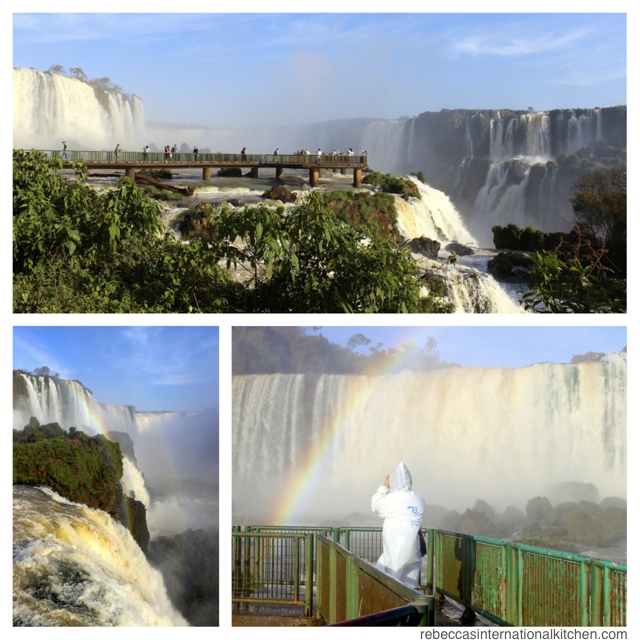
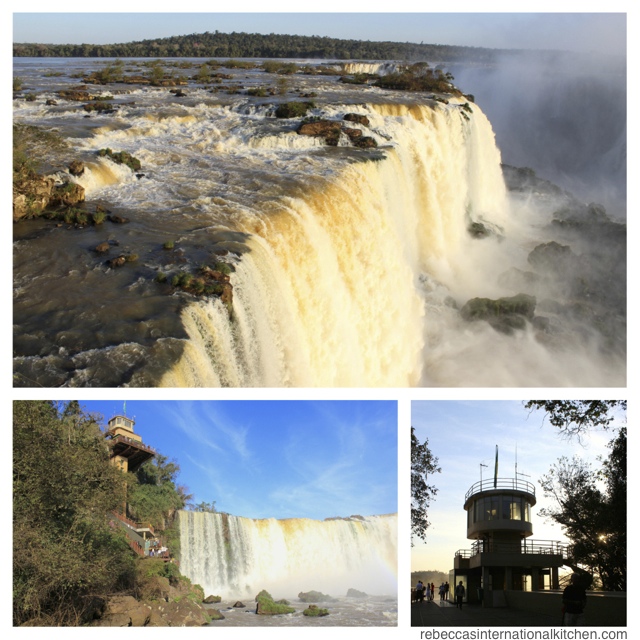
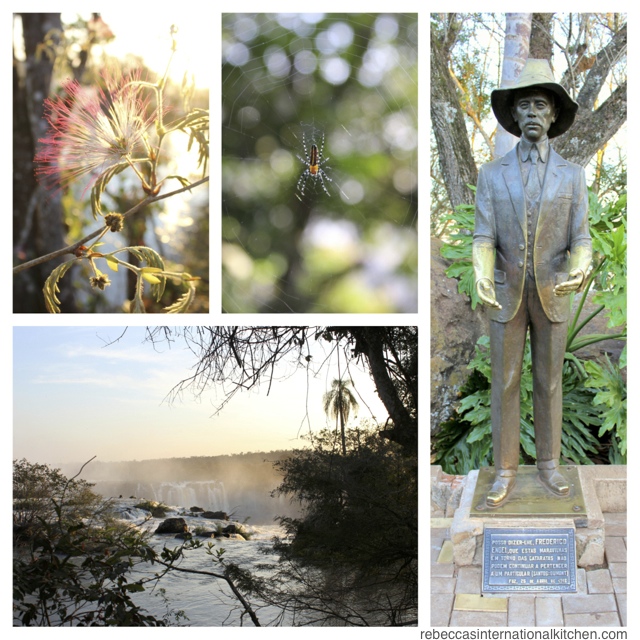
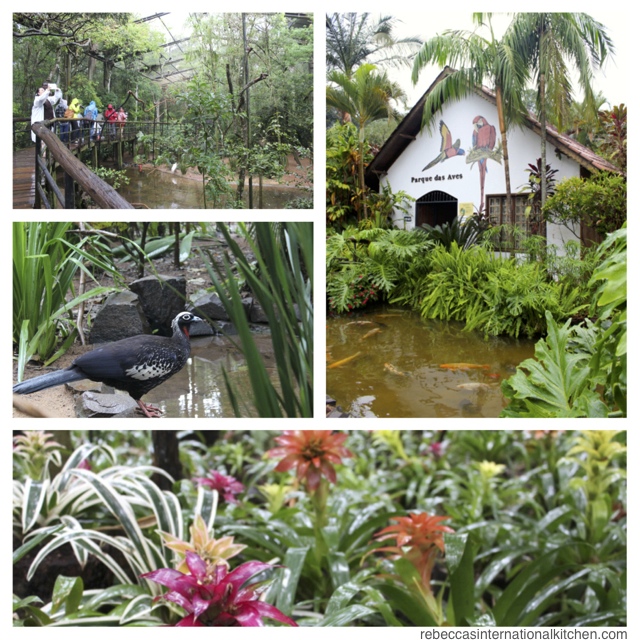

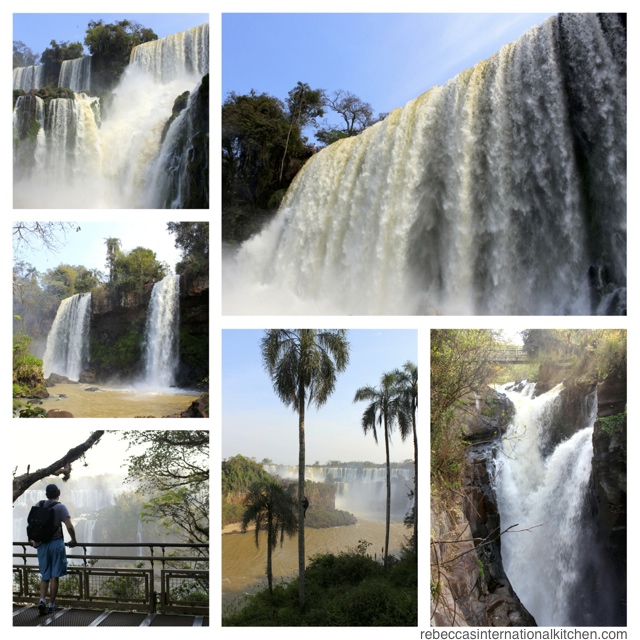
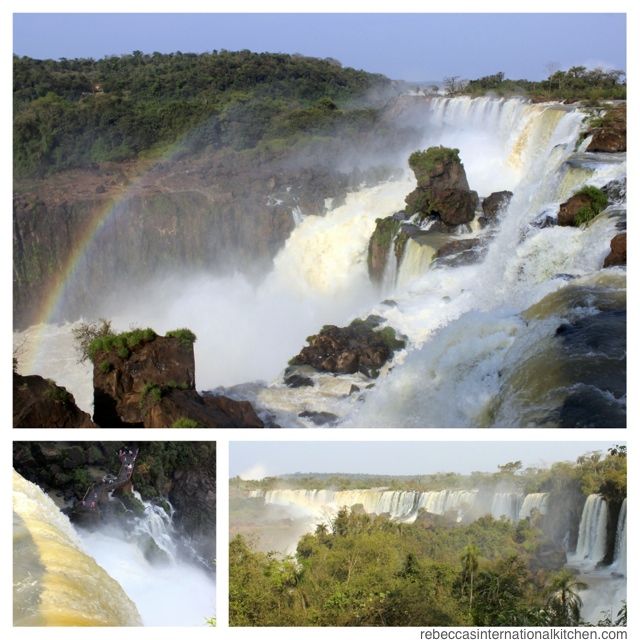



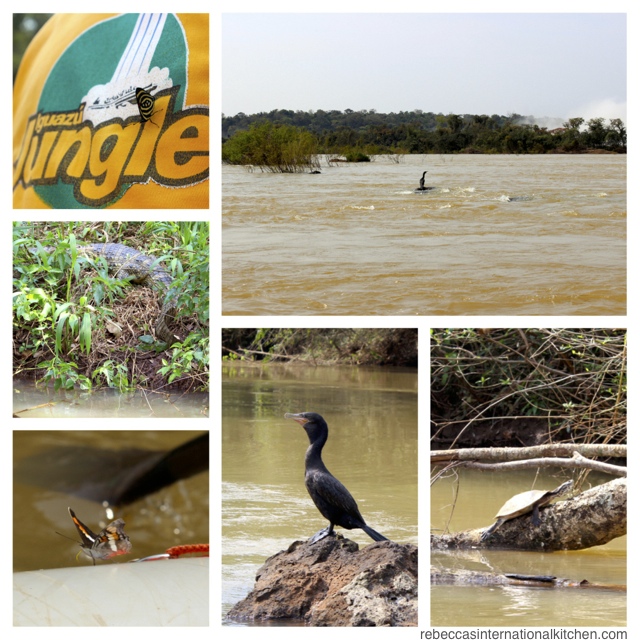
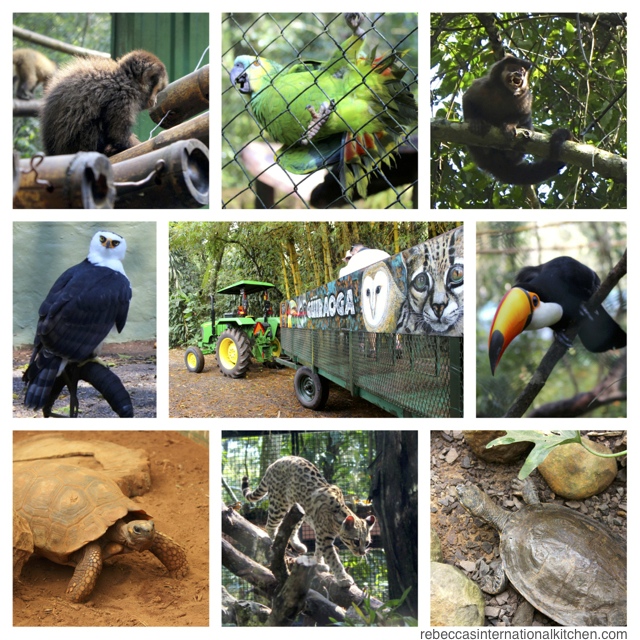
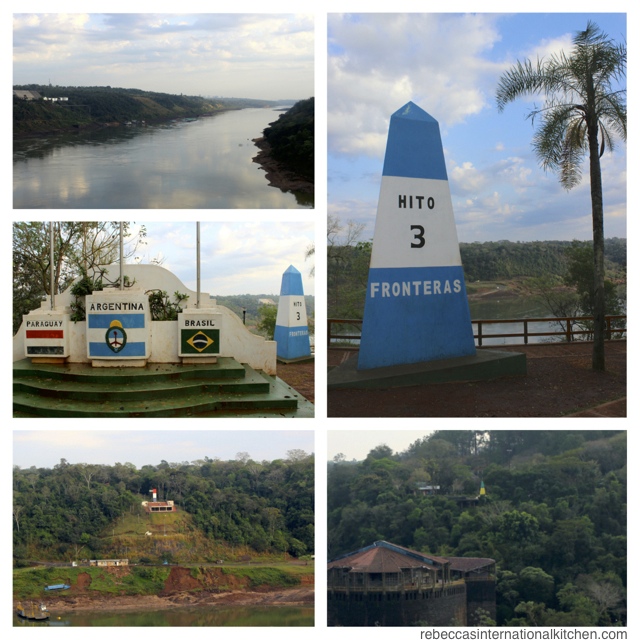









Pingback: Rebecca's International Kitchen - Tips for Making the Most of Your Time at Iguazú Falls